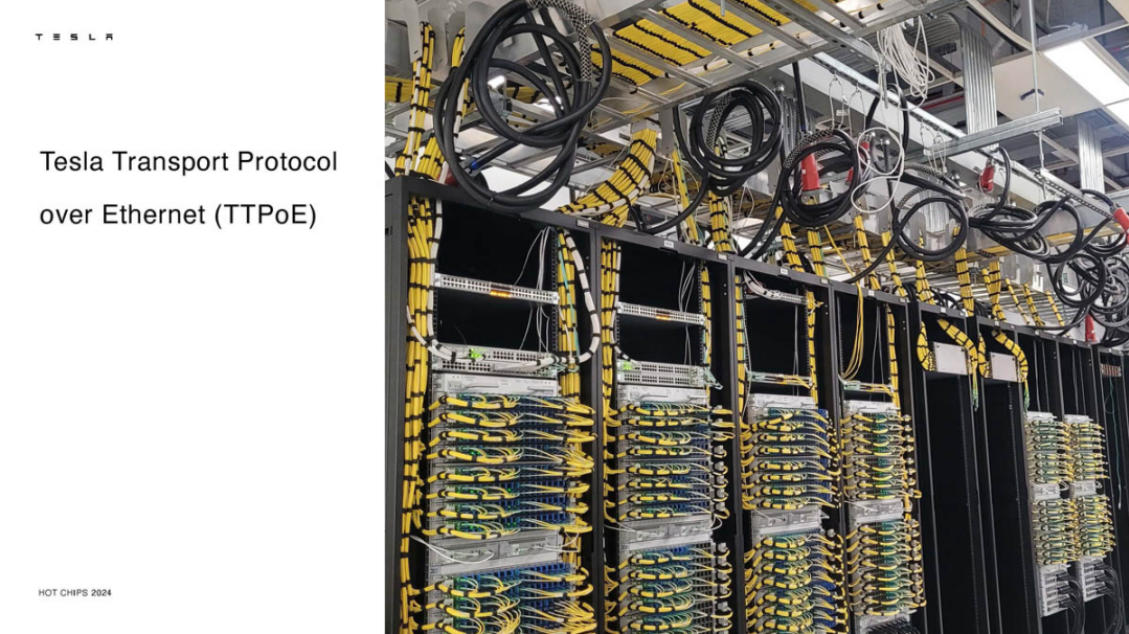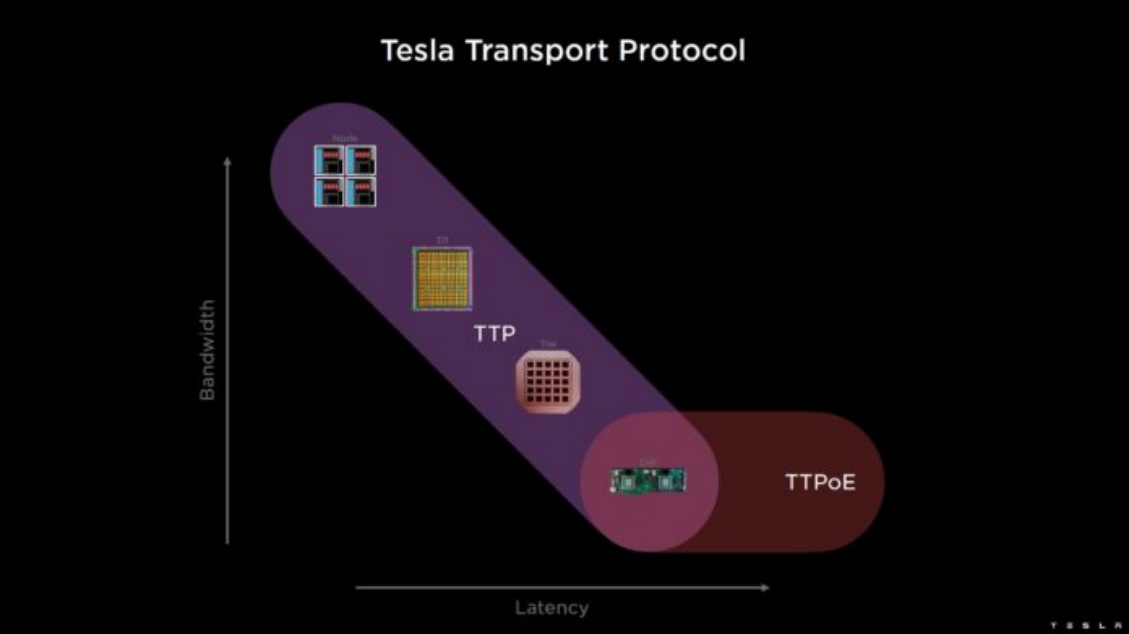
TTPOE (Tesla Transport Protocol over Ethernet) is an Ethernet transmission protocol launched by Tesla at Hot Chips 2024. It is a new transmission protocol developed by Tesla for its Dojo supercomputer, which aims to replace the traditional TCP protocol to achieve lower latency and higher bandwidth communication. At the same time, Tesla announced that it has joined the UltraEthernet Alliance.
This article will explore TTPoe's development, technical underpinnings, and its broader implications for the future of communication.
Background and Development
TTPoe was conceived to address the increasing communication demands in Tesla's advanced vehicular systems. As vehicles become more autonomous and interconnected, the necessity for a robust communication protocol becomes evident. Tesla, a leader in automotive innovation, developed TTPoe to ensure seamless integration and operation of its vehicles' sophisticated components.
The protocol's development involved collaboration among top engineers and technology experts, focusing on creating a system that could handle high data loads efficiently. This initiative was driven by the need to support an increasing number of sensors and smart features in vehicles, ensuring all components work in harmony.
Technical Overview
In traditional supercomputer networks, the common transmission protocol is TCP/IP. However, although TCP/IP is stable and reliable, it may not be applicable to some high-performance computing tasks. Although TCP's connection management, congestion control, and reliability guarantee mechanisms are suitable for general network environments, in computing environments that require extremely low latency and high bandwidth, its complex state machine and long waiting states will become bottlenecks.
Technology Principles
At its core, TTPoe is designed to provide a high-speed, low-latency communication channel across vehicular systems. Unlike traditional protocols that often face bandwidth and latency constraints, TTPoe is engineered for hardware execution, minimizing delays and enhancing real-time data exchange. This is crucial for autonomous driving systems and advanced driver-assistance systems (ADAS).
TTPoe employs a unique method of congestion management by utilizing local link channels rather than relying on network switches. This approach significantly reduces congestion management complexity and avoids bottlenecks, ensuring that communication remains uninterrupted even under heavy data loads.
TTPoE is implemented entirely in hardware, and its state machine is simplified compared to the TCP protocol, thus providing lower latency. The TCP protocol needs to go through multiple steps when closing a connection, such as sending FIN, waiting for confirmation, reconfirmation, etc., and finally enters the TIME_WAIT state. TTPoE reduces latency by removing the TIME_WAIT state and simplifying the process of closing a connection from three steps to two steps. This simplification also includes simplifying TCP's three-way handshake (SYN, SYN-ACK, ACK) to a two-way handshake when establishing a connection.

Parameters and Specifications
Data Rate and Bandwidth: Supporting high data rates, TTPoe efficiently handles extensive information exchange between sensors, cameras, and control units, essential for timely decision-making in autonomous systems.
Latency: TTPoe achieves microsecond-level latency, vital for applications requiring immediate response, such as collision avoidance and real-time navigation adjustments.
Scalability: The protocol's flexible architecture allows it to scale with the growing number of devices and sensors in modern vehicles, adapting to various network sizes and data demands.
Reliability and Error Handling: Advanced error correction techniques are employed to maintain data integrity, minimizing transmission errors and ensuring reliable communication.
Security: With cybersecurity being a priority in connected vehicles, TTPoe integrates encryption and secure authentication to protect against unauthorized access and data breaches.
Integration with AI Systems: TTPoe is optimized for integration with AI systems, particularly Tesla's Dojo supercomputer, facilitating efficient data handling necessary for AI model training and operation.
Applications and Use Cases
The advanced capabilities of TTPoe make it a versatile protocol with potential applications beyond the automotive sector. In addition to supporting autonomous vehicles, TTPoe's low latency and high data throughput are beneficial for industrial automation systems, where precise timing and data accuracy are crucial. Furthermore, as smart city infrastructure develops, TTPoe could play a vital role in enabling efficient communication between urban systems, enhancing traffic management and public safety.
Benefits and Challenges of TTPoE
Comparison with TCP/IP
Compared with the traditional TCP/IP protocol, TTPoE has obvious advantages in latency, bandwidth utilization and implementation complexity. TTPoE eliminates the lengthy connection and closing process in TCP, reduces unnecessary waiting time, and thus reduces network latency.
TTPoE uses a fixed congestion window mechanism to manage data transmission through hardware, thereby avoiding the additional overhead caused by dynamically adjusting the window in TCP. Finally, the hardware implementation of TTPoE makes its processing faster and transparent to upper-layer applications, which simplifies the difficulty of application development.
Comparison with Infiniband
Infiniband is a network technology widely used in the field of high-performance computing, known for its high bandwidth and low latency. Compared with Infiniband, although TTPoE provides slightly different bandwidth and latency in theory, it has advantages in cost and implementation complexity.
Infiniband relies on a credit system controlled by the switch to manage congestion, while TTPoE handles congestion through packet loss and retransmission mechanism, which is simpler and reduces the design complexity of network switches.
In addition, TTPoE is based on standard Ethernet hardware implementation, which means Tesla can use the existing Ethernet infrastructure without deploying expensive Infiniband equipment. For companies like Tesla that need to deploy computing nodes on a large scale, the cost-effectiveness of TTPoE is particularly important.
TTPoe offers numerous advantages over traditional communication protocols. Its high-speed data transmission capabilities ensure that critical information is relayed promptly, essential for the safe operation of autonomous vehicles. The use of Ethernet technology allows for leveraging existing infrastructure, reducing implementation costs.
Despite its benefits, TTPoe faces challenges, such as the need for widespread adoption across the automotive industry to realize its full potential. This requires collaboration among manufacturers, suppliers, and technology providers to standardize the protocol and ensure compatibility. Additionally, addressing cybersecurity concerns is crucial to protect against potential threats.
Future Prospects & Innovations
The future of TTPoe looks promising, with ongoing research focused on enhancing its capabilities and expanding its applications. As the automotive industry continues to evolve, TTPoe is expected to play a crucial role in developing more advanced and efficient vehicles. Innovations such as improved data encryption and enhanced error handling are being explored to further bolster the protocol's reliability and security.
Moreover, as smart cities and interconnected systems become more prevalent, TTPoe could serve as a foundational technology that enables seamless communication between various components. This presents opportunities for innovation in areas such as traffic management, public transportation, and infrastructure monitoring, where real-time data exchange is critical.
Endnote
The emergence of Tesla TTPoE marks a new breakthrough in network transmission technology in the field of AI. By reducing latency and increasing throughput, TTPoE is expected to accelerate AI training and reasoning, and promote the application of AI technology in more fields.
Follow VCOM to learn more information about Ethernet communication technology.
Tag:TTPoE,Ethernet




